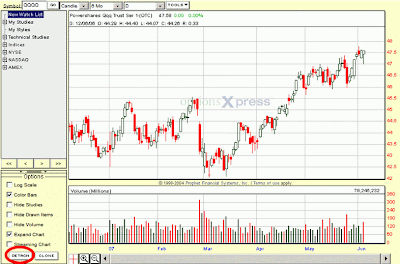Gamma measures the rate of change of
delta due to a one-point change in
the price of the underlying stock. In other words, Gamma estimates how much delta would change if the price of the underlying stock changes by $1. So, gamma can tell you how �stable� your delta is. A big gamma means that your delta can start changing considerably for even a small move in the stock price.
Unlike delta,
gamma is always positive for both Calls and Puts.
Example:ABC Jun 60 Call has a delta of +0.25 and ABC Jun 60 Put has a delta of -0.75. The current ABC stock price is 50. The gamma for both the ABC Jun 60 Call and Put is 0.03.
If the stock increases by $1 from $50 to $51, the delta of ABC Jun 60 Call will become +0.28 [= +0.25 + ($1 * 0.03)], and the delta of ABC Jun 60 Put becomes -0.72 [= -0.75 + ($1 * 0.03)].
If the stock falls by $1.00 to $49, the delta of ABC Jun 60 Call becomes +0.22 [= +0.25 + (-$1 * 0.03)], and the delta ABC Jun 60 Put becomes -0.78 [= -0.75 + (-$1 * .03)].
Gamma and the position in the market:* Both long calls and long puts always have positive gamma.
* Both short calls and short puts always have negative gamma.
* Stock has zero gamma because its delta is always 1.00 � it never changes.
Initially, it was quite hard for me to understand why �both long calls & long puts always have positive gamma� and �both short calls and short puts always have negative gamma�. Until I drew a �
delta ruler� (see picture below) which could really help me to understand the above concepts.

Now, I�ll try to elaborate more on how this �ruler� has helped me to understand Gamma concepts.
Before we start, let�s refresh the concepts we discussed earlier in �
Delta � Part 1�:
* Long calls have positive delta; short calls have negative delta.
* Long puts have negative delta; short puts have positive delta.
POSITIVE GAMMA means the delta will increase when the underlying stock price increases, and will decrease when the stock price decrease (
positive relationship).
What does �long calls have positive gamma� mean?Since
the delta of long calls is positive, when the stock price rises, the delta of long calls will increase, i.e. it becomes more positive and moves towards +1.
In contrast, when the stock price falls, the delta of long calls will decrease, whereby it becomes less positive and moves towards 0.
And what does �long puts have positive gamma� mean?Since
the delta of long puts is negative, when the stock price rises, the delta of long puts will increase, whereby it becomes less negative and moves towards 0.
On the other hand, when the stock price falls, the delta of long puts will decrease, meaning that it becomes more negative and moves towards -1.
NEGATIVE GAMMA means the delta will decrease when the underlying stock price rises, and will increase when the stock price drops (
negative relationship).
What does �short calls have negative gamma� mean?Since
the delta of short calls is negative, when the stock price rises, the delta of short calls will decrease, i.e. the delta becomes more negative and moves towards -1.
On the other hand, when the stock price falls, the delta of short calls will increase, whereby the delta becomes less negative and moves towards 0.
What does �short puts have negative gamma� mean?Since the delta of short puts is positive, when the stock price rises, the delta of short puts will decrease, whereby the delta becomes less positive and moves towards 0.
On the contrary, when the stock price falls, the delta of short puts will increase, i.e. the delta becomes more positive and move towards 1.
Gamma of ATM, ITM & OTM OptionsGamma is the largest for the At-The-Money (ATM) options, and gradually gets lower as it moves furthers towards In-The-Money (ITM) and Out-Of-The-Money (OTM). This means that the delta of ATM options changes the most when the stock price moves up or down, as compared to ITM & OTM options.
Hence, practically speaking, an ATM Call can provide a good balance of potential profit if the stock rises versus loss if the stock falls. An OTM Call will not make as much money if the stock price increases, and an ITM will lose more money if the stock price drops.
To read about other Option Greeks, go to:
Option Greeks.
Related Posts:
*
FREE Trading Videos from Trading Experts You Should Not Miss*
OPTION PRICING: How Is Option Priced?*
Understanding Implied Volatility (IV)*
Difference Between Option�s Volume and Open Interest*
Options Trading Basic � Part 2
 7:51 AM
7:51 AM
 killnine
killnine








 For ATM option, Theta increases as an option get closer to the expiration date.
For ATM option, Theta increases as an option get closer to the expiration date.









